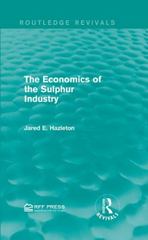Question
Y7 Part 1. In New York, delivery company D operates as a monopolist in the package delivery market. In each day, the company faces a
Y7
Part 1. In New York, delivery company D operates as a monopolist in the package delivery market. In each day, the company faces a downward sloping demand curve of p = 100 - 10*x, where x is the number of packages delivered. The company specializes in the delivery of very large packages, so a different vehicle is needed for each package delivered. In any day, the delivery cost for a standard package within New York is 2.5*x per unit delivered. Note: display your results using 4 decimals.
(a) Determine the optimal number of packages delivered by D per day. Determine the firm's optimal profit in each day.
(b) The number of delivery vehicles negatively impact the business of New York taxi drivers, who operate in perfect competition. The price of a standard trip within New York is 10 dollars, and the cost of carrying a passenger is c(y,x) = 0.2*x +2*y per trip, where x is the number of delivery vehicles, and y is the number of daily trips. Find the maximum daily profit of a taxi driver. There are 100 taxi drivers in New York: what's the total industry profit?
(c) Does the number of vehicles of company D negatively affect welfare in this economy? Find the number of vehicles and taxi trips that would maximize the sum of the welfare of the delivery company and the taxi drivers in New York (i.e., find the social planner solution). Was welfare at points (a) and (b) larger? (Hint: remember that there are 100 taxi drivers).
(d) Determine the Pigouvian tax needed to reach the optimum.
(e) Instead of using a tax, the legislator decides to give the taxi drivers the property rights on the congestion externality. Without solving for the bargaining problem, determine if the efficient outcome can be realized in this situation.
(f) Now, the property rights on the externality are assigned to firm D, instead. Without solving for the optimal bargaining outcome, will the efficient outcome be realized?
Part 2. In the spirit of part 1, describe a real-world situation where a Pigouvian tax is more likely to achieve the efficient outcome than Coasian bargaining. Why is it the case? What assumptions of the Coase theorem are not satisfied? What other policy could have been enforced to limit the negative externality?
Step by Step Solution
There are 3 Steps involved in it
Step: 1

Get Instant Access to Expert-Tailored Solutions
See step-by-step solutions with expert insights and AI powered tools for academic success
Step: 2

Step: 3

Ace Your Homework with AI
Get the answers you need in no time with our AI-driven, step-by-step assistance
Get Started


